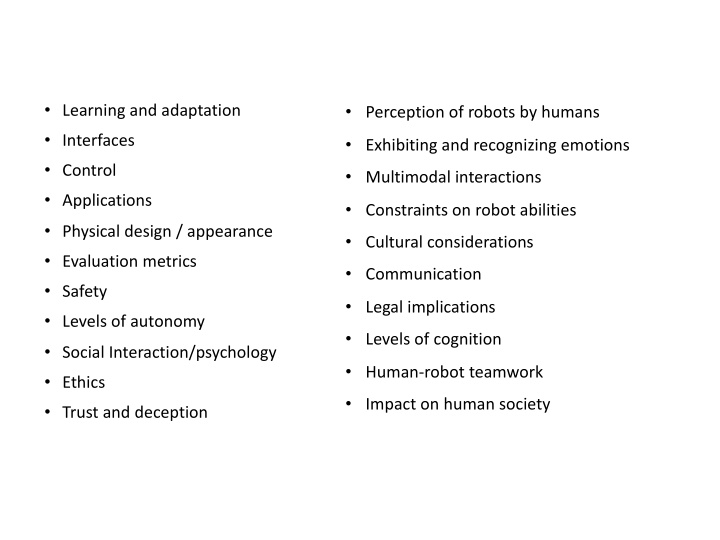



• Learning and adaptation • Perception of robots by humans • Interfaces • Exhibiting and recognizing emotions • Control • Multimodal interactions • Applications • Constraints on robot abilities • Physical design / appearance • Cultural considerations • Evaluation metrics • Communication • Safety • Legal implications • Levels of autonomy • Levels of cognition • Social Interaction/psychology • Human-robot teamwork • Ethics • Impact on human society • Trust and deception
Research Novelty Tech Pervasive Tools Image courtesy of Chad Jenkins
Research Novelty Tech Pervasive Tools Image courtesy of Chad Jenkins
Research Novelty Tech Pervasive Tools Image courtesy of Chad Jenkins
Research Novelty Tech Pervasive Tools Image courtesy of Chad Jenkins
Timeline of HRI 1941 – Asimov’s I, Robot …. 1992 - IEEE International Symposium on Robot and Human Interaction Communication 2006 – HRI conference 2009 – International Journal of Social Robotics 2011 – Pres. Obama launches National Robotics Initiative 2012 – Journal of Human Robot Interaction
Why the increasing importance of HRI? Many reasons… but ultimately because all robots have some dependency on humans.
Technology Pipeline HRI becomes critical
What does society want to do with robots?
2 Case Studies • Autonomous City Explorer (ACE) • Home Exploring Robotic Butler (HERB)
What perceptual capabilities does an interactive robot need? • Person detection • Object recognition • Scene recognition • Face recognition • Speech recognition • Gesture recognition • Intonation recognition • Posture and proximity recognition • Emotion recognition • …smell? • …
Object Affordances
Robot sensing… This is where we want to be… This is where we are…
Autonomous City Explorer Next generation of ACE
FSM for Vision Subsystem
Behavior Control s = subsystem p = priority b= behavior * new trigger _ a active
HERB
System Architecture
Take a note card and summarize any observations, contrasts, questions or comments you have regarding the papers. Brief statements/bullet points are fine.
As a group: 1. Briefly analyze both the ACE and HERB platform within the HRI Taxonomy 2. Note the differences in the designs of these systems at the hardware, sensor or architecture level 3. Identify the source of each difference (e.g., application-driven, cost-driven, unknown…) 4. What scientific impact does each robot make? 5. What are the most significant limitations of each platform, for its given application?
Recommend
More recommend